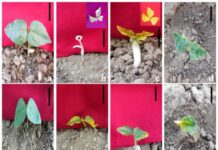A recent article by Munzhelele, et al., (2024) titled “Impact of weirs in altering benthic macroinvertebrate assemblages and composition structure in the Luvuvhu River Catchment, South Africa” published in Frontiers in Environmental Science, shows that habitat Integrity plays a crucial role in driving aquatic abundance and assemblage in the Luvuvhu River Catchment (LRC), emphasizing the importance of maintaining ecological integrity.
“
Weirs significantly alter benthic macroinvertebrate assemblages, emphasizing the critical role of habitat integrity in river ecosystems – Munzhelele, et al., 2024
The study delves into the impact of weirs on benthic macroinvertebrate assemblages in the Luvuvhu River Catchment, South Africa. Assessing six weirs across five streams, the research utilizes a year-long sampling approach, employing the South African Scoring System (SASS) and Average Score per Taxon (ASPT) indices for analysis. The findings, drawn from 18,914 macroinvertebrate individuals representing 65 families, highlight the pivotal role of habitat integrity in shaping aquatic abundance and assemblage composition. These results underscore the ecological significance of preserving river integrity to sustain diverse aquatic ecosystems.
How the Study was Conducted
The research was conducted at six weirs within the Luvuvhu River Catchment (LRC) in South Africa. The catchment area and geographic coordinates of the sampling sites are detailed. Bi-monthly measurements of water temperature, dissolved oxygen, pH, total dissolved solids, and electrical conductivity were taken at sites upstream and downstream of each weir. The authors employed macroinvertebrates from three main biotopes at each sampling point over a 12-month period. The sampling involved kick sampling and the use of a standard SASS kick net. Statistical analyses were performed using R software. The South African Scoring System (SASS) score and Average Score per Taxon (ASPT) indices were used to assess macroinvertebrate assemblages. Generalized linear mixed models (GLMM) and canonical correspondence analysis (CCA) were employed to analyze the data.
What the Authors Found
The authors found that habitat Integrity plays a crucial role in driving aquatic abundance and assemblage in the Luvuvhu River Catchment (LRC), emphasizing the importance of maintaining ecological integrity. The authors also found that the presence of weirs significantly alters benthic macroinvertebrate assemblages and composition structure both upstream and downstream, affecting the river’s functionality and biodiversity. In addition, a total of 18,914 macroinvertebrate individuals from 65 families were observed, indicating a diverse range of species affected by the weirs.
Why is this Important
Habitat Integrity: It highlights the significance of maintaining the ecological integrity of rivers for the abundance and assemblage of aquatic life.
Impact Assessment: It provides an impact assessment of weirs on benthic macroinvertebrate assemblages in the Luvuvhu River Catchment, which is crucial for understanding human impacts on river ecosystems.
Bioassessment Tool: The study utilizes the South African Scoring System (SASS) as a bioassessment tool, demonstrating its effectiveness in detecting water quality impacts.
Conservation Efforts: The findings can inform conservation efforts and sustainable management practices for rivers affected by flow modifications due to weirs.
What the Authors Recommend
- The authors advocate that implementing conservation measures to maintain the ecological integrity of rivers, especially those impacted by weirs, is crucial. These measures could include habitat restoration, flow management, and minimizing human disturbances.
- The authors emphasize that establishing long-term monitoring programs for river ecosystems can help assess the impact of weirs on aquatic life. Regular monitoring allows for adaptive management and timely interventions.
- When constructing or modifying weirs, consider their design and placement carefully. Optimal weir design can minimize negative effects on benthic macroinvertebrate assemblages.
- In addition, the study also emphasizes on educating the public and stakeholders about the importance of maintaining healthy river ecosystems. Awareness campaigns can promote responsible behavior and reduce human impacts.
In conclusion, the study underscores the critical importance of maintaining habitat integrity in river ecosystems, particularly in the context of weirs’ impact on benthic macroinvertebrate assemblages. By revealing the significant alterations caused by weirs in the Luvuvhu River Catchment, South Africa, the research highlights the urgent need for conservation measures and responsible management practices. Through ongoing monitoring, informed interventions, and public education initiatives, we can strive towards preserving the ecological balance of rivers, safeguarding the diverse aquatic life they support for generations to come.
















 The African Research (AR) Index is a comprehensive scholarly directory and database focused explicitly on journal publishers that publish and disseminate African research.
The African Research (AR) Index is a comprehensive scholarly directory and database focused explicitly on journal publishers that publish and disseminate African research.

